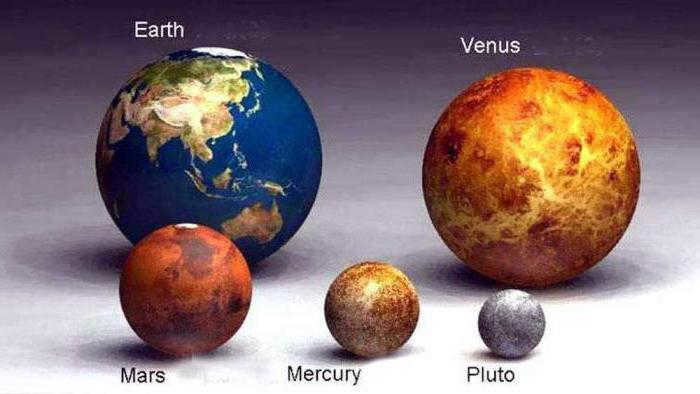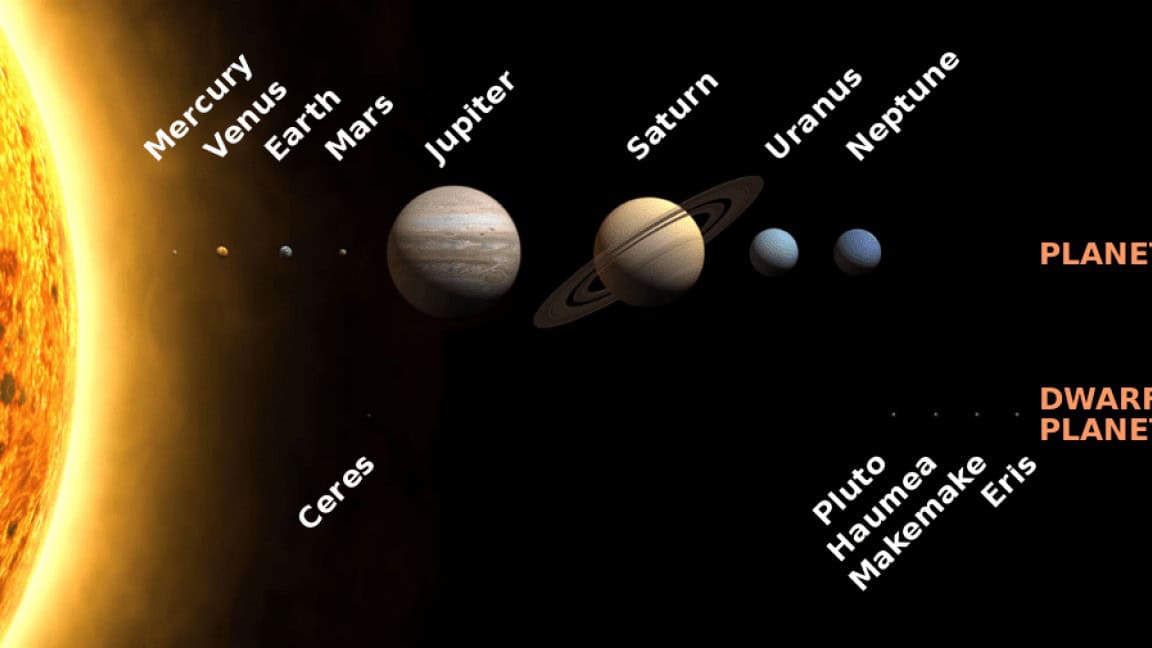Mercury, being the closest planet to the Sun, has an orbital period of approximately 88 Earth days. The planet’s mass is about 0.055 times that of the Earth, and it was given the name of the Roman messenger god.
What causes the nights on Mercury to be extremely cold, despite its proximity to the Sun?
The lack of an atmosphere on Mercury is the main reason why its nights are incredibly cold. Without an atmosphere to trap and retain heat, the planet experiences rapid heat loss, causing temperatures to plummet during the night.
What is the appearance of Mercury’s surface?
When observing Mercury up close, one would notice that its surface bears a striking resemblance to that of the Moon. It is characterized by hills and cliffs covered in a layer of dust, along with numerous craters. Furthermore, the planet possesses a substantial metallic core that is both dense and expansive.
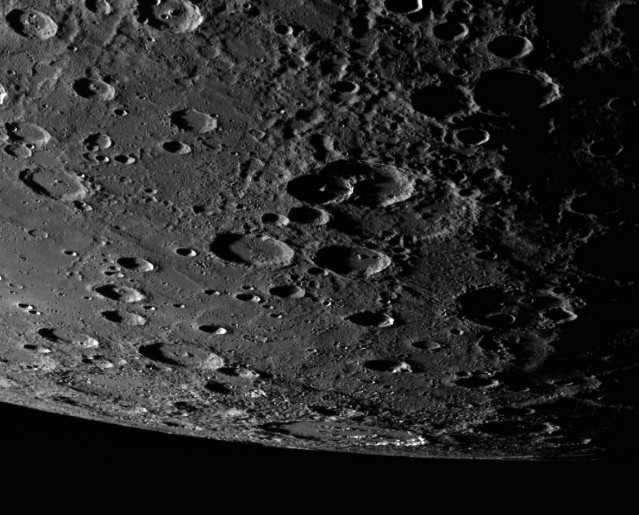
When you closely examine Mercury, you will notice that its surface is filled with large craters. Any celestial object that approaches Mercury collides with its surface and creates a crater, since there is no atmosphere to burn it up upon entry.
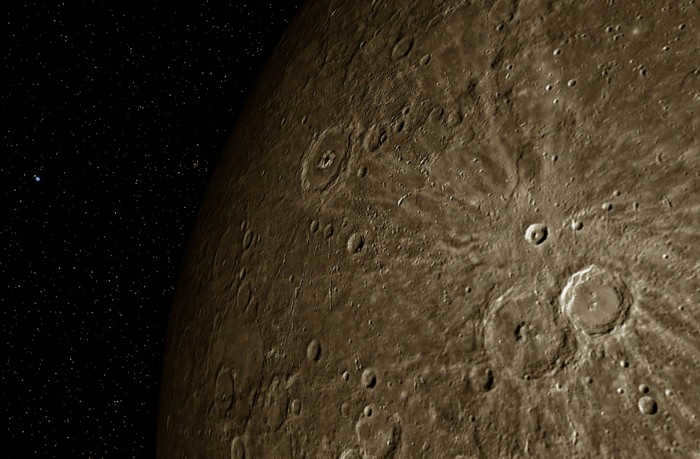

Mercury’s surface is filled with craters and seas. There is currently a debate among scientists regarding whether Mercury possesses a solid metallic core.
Which space probes have landed on Mercury?
Mercury is the least explored planet. The Mariner 10 spacecraft, which extensively studied Mercury from 1974-1975, only mapped approximately 40-45% of its surface. The MESSENGER interplanetary station (NASA) conducted its initial flyby of the planet in January 2008. It is projected to enter into Mercury’s orbit in 2011.
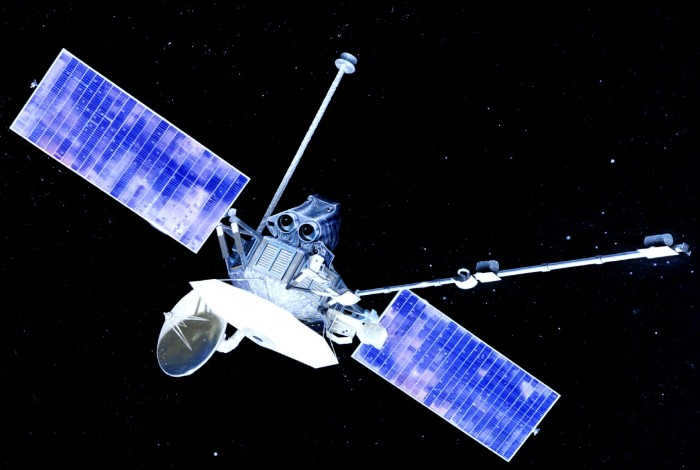
Up to this point, the only spacecraft that has had the capability to capture photographs of Mercury is the Mariner 10. By utilizing the images obtained from the Mariner 10 as well as the photos taken by MESSENGER, scientists have successfully created the initial comprehensive map of Mercury.
What is the duration of time it takes for Mercury to complete a full revolution around the Sun?
Mercury orbits the Sun in an elliptical path that is highly elongated. The completion of one full revolution for Mercury takes nearly 88 days.
How long does it take for Mercury to complete one rotation?
Mercury has a very slow rotation speed. It takes 58.65 Earth days for Mercury to complete one rotation on its own axis. This means that a day on Mercury is almost 59 Earth days long! Over the course of 176 Earth days, Mercury completes three full rotations around its axis and also completes two rotations around the Sun.
What causes the formation of large craters on Mercury?
The lack of atmosphere on Mercury is the main reason why there are such massive craters on its surface. Without an atmosphere to burn them up, meteorites often collide with the planet’s surface, creating these large craters. Additionally, the absence of any apparent geologic activity on Mercury allows these craters to persist without being altered or erased over time.
What is the color of the sky on Mercury?
The sky on Mercury appears dark, even during the day, when observed from the planet’s surface. This is due to the absence of an atmosphere that would scatter sunlight.
Which crater on Mercury is the biggest?
The Heat Plain is the largest crater on Mercury, measuring approximately 1,300 kilometers in diameter. It ranks among the largest craters in the entire solar system.
Mercury, the planet closest to the Sun, completes its entire orbit around the Sun in just 88 days. Apart from Pluto, it is the smallest planet in our solar system. The surface of this small planet is incredibly hot, reaching temperatures high enough to melt tin and lead. Mercury has a minimal atmosphere and its solid ground is dotted with craters.
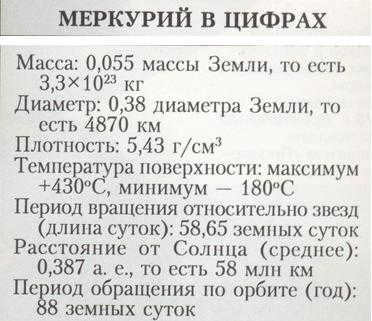
Mercury’s orbit is situated closer to the Sun as compared to Earth’s orbit. Because of this, Mercury always appears to be in close proximity to the Sun when observed from our perspective. During its 88-day orbit, there are only a few instances when Mercury is far enough away from the Sun to be visible to the naked eye. During these times, it can be seen low on the horizon in a sky illuminated by twilight. Unfortunately, Mercury is never visible in a sky that is completely devoid of light.
The optimal time to observe Mercury is either in the evening sky during spring or before dawn in the autumn. To ensure that you do not miss the prime viewing days, consult the annual astronomical guide or read the monthly astronomy column in the newspaper. Equipped with binoculars, you will have a greater chance of locating Mercury in the sky, but it is important to refrain from using them until after sunset. Mercury will appear as a brilliant star. Once you have identified it with binoculars, you will also be able to see Mercury with the naked eye.
Mercury’s lengthy day
Mercury completes a full rotation around its axis in 59 Earth days. It is plausible that at some point in the past, Mercury had a faster rotation, but the gravitational force exerted by the Sun gradually decelerated its spin.
It takes Mercury 59 Earth days to complete one orbit around its axis. Begin at the location where the arrow is directed towards the Sun. Then, trace the path of the orbit and observe as Mercury slowly rotates while orbiting the Sun. The arrow will complete one revolution when Mercury is approximately two-thirds of the way around the Sun. Prior to the arrow pointing to the Sun again, the planet will have completed two full orbits. Consequently, Mercury’s day lasts for two of its years.
Mercury completes three rotations on its axis while completing two full orbits around the Sun. Within one rotation on its axis, it covers two-thirds of its orbit. Therefore, if you were on Mercury, you would observe two “Mercurian years” between consecutive sunrises, equivalent to 176 Earth days. Additionally, you would witness significant variations in the apparent size of the Sun due to the elongated nature of Mercury’s orbit. Throughout the extremely lengthy “days,” the temperature at Mercury’s equator can reach up to 430°C, which is sufficient to liquefy tin, lead, and zinc.
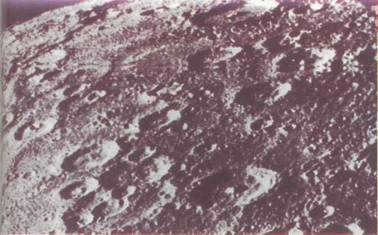

Scarcity of Atmosphere
Mercury’s atmosphere is extremely scarce. In the past, there might have been some gases present, but they have long evaporated under the scorching rays of the sun. Nevertheless, Mercury still manages to capture certain amounts of hydrogen and helium gas emissions that emanate from the Sun. Additionally, searing hot rocks emit sodium atoms, resulting in the existence of a relatively thick atmospheric layer, primarily composed of sodium with small traces of helium and hydrogen.
Due to the absence of air and clouds, weather prediction on Mercury would be quite straightforward: unbearably hot during the day and freezing cold at night, particularly in the polar regions.
The planet Mercury is so far away that details of its surface cannot be observed through a telescope. However, in 1974 and 1975, the Mariner 10 spacecraft captured over 10,000 images of Mercury’s surface, providing valuable insights. These images reveal the presence of craters and cracks that measure less than 100 meters in width. In fact, Mariner 10 managed to photograph nearly half of the entire planet. The surface of Mercury is characterized by an abundance of craters, similar to those found on the moon. One notable feature is the Caloris Basin, a massive circular formation spanning 1300 kilometers in diameter. It is believed that this basin may have formed due to a collision with a large asteroid. Additionally, the surface of Mercury exhibits both small bowl-shaped craters and larger craters with distinct central peaks. The presence of numerous craters suggests that the planet has experienced numerous meteorite and asteroid impacts throughout its history.
Not long after the formation of the planets, approximately 5 billion years ago, there were numerous random fragments of solid rock, rocks, and asteroids that were scattered throughout the inner regions of the solar system. These fragments collided with the surfaces of the planets, leaving behind evidence of these impacts that can still be observed today on bodies like Lupus and Mercury. Unlike Earth, these celestial bodies lack an atmosphere and water, which means that their craters have not been subject to any erosion.
CRUCIAL DISCOVERIES
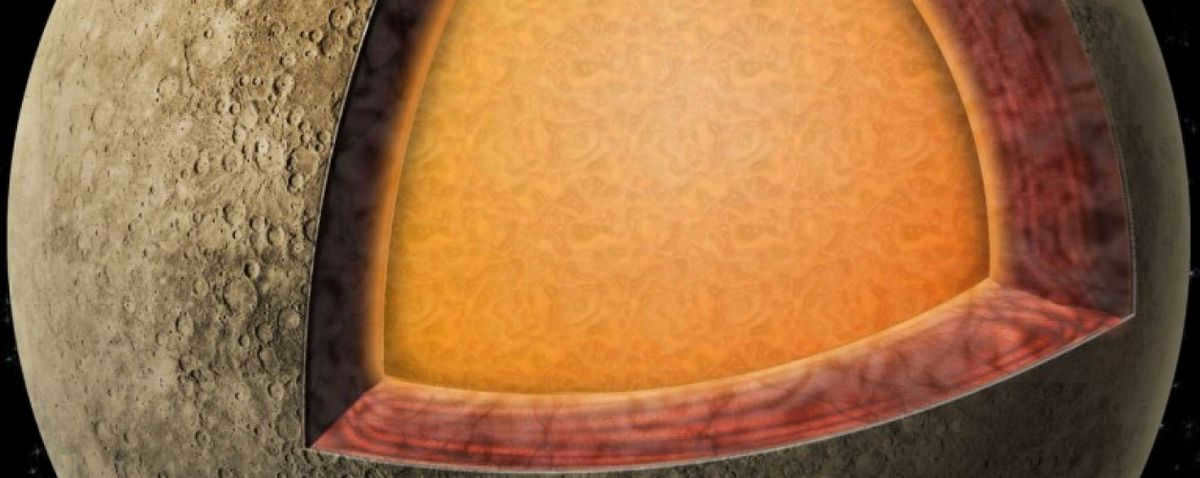

Mercury has been recognized since ancient times, but early astronomers did not immediately comprehend that they were observing the same celestial body both in the morning and evening.
Due to its narrow orbit, the planet is only 27.3° to the east or west of the Sun when observed from Earth.
During its farthest points from the Sun, known as elongations, Mercury can be seen with the naked eye shortly after sunset or shortly before sunrise.
The planet possesses an average brightness of approximately -0.4 magnitude (ranging from +5 magnitude to -2 magnitude) and an angular size of about 8 arcseconds (ranging from 5 to 11 arcseconds). It is impossible to discern any surface features on Mercury through an amateur telescope. The best that can be observed are its phases, akin to the phases of the Moon.
The mean distance from the sun to the planet Mercury is approximately 57.9 million kilometers (0.387 astronomical units). However, this measurement fluctuates due to its placement in an extremely elongated orbit, ranging from 46.08 to 68.86 million km.
The Earth’s distance to Mercury spans between 82 and 217 million kilometers.
Because of the gravitational pull of the Sun, Mercury is caught in a resonance trap, resulting in an 88 Earth-day orbital period around the Sun. A day on Mercury lasts for 176 Earth days, during which the planet completes three full rotations on its axis. In the same time span, Mercury makes two orbits around the Sun.
The Sun rises in the east and moves very slowly (about one degree per twelve hours), reaching its highest point (zenith) at the equator before gradually setting. However, this phenomenon does not occur everywhere. In certain locations, the Sun rises, abruptly stops, reverses its direction, and sets almost at the same spot where it first rose. After a few Earth days, the Sun rises again from the same point and remains visible for an extended period. The same pattern repeats in reverse during sunset. This occurrence is known as the Joshua effect, named after the biblical figure who was said to have halted the Sun. In some places, there are two sunrises and two sunsets in a single day.
The distance between Mercury and Earth varies from 82 to 217 million kilometers. Mercury moves faster across the sky compared to other planets, with an average orbital speed of 47.89 km/s around the Sun. This is why the planet was named Mercury, after the swift-footed ancient Roman god of commerce.
Mercury is the smallest planet in the Solar System’s terrestrial group. It has one twentieth the mass of Earth and a radius that is 2.5 times smaller.
The planet has a rotation period of 58.6 days and an average diameter of 4878 kilometers, with a mass of 3.3-1023 kilograms.
Due to its proximity to the Sun,
Mercury experiences scorching daytime temperatures that soar to 4,427 degrees Celsius,
while nighttime temperatures plunge to a frigid -162 degrees Celsius.
Gravity’s pull on Mercury is measured at 3.70 m/s².
Furthermore, the second cosmic velocity is recorded at 4.25 km/s.
Mercury’s Atmosphere
The atmosphere surrounding the planet Mercury is incredibly thin. The atmospheric pressure on the surface of Mercury is 500 billion times less than that on Earth’s surface.
Its composition consists of:
- He (helium). Due to its proximity to the Sun, Mercury captures the solar wind with its gravity. Once captured, a helium atom remains in the atmosphere for an average of 200 days.
- H (hydrogen). The total number of hydrogen atoms and molecules in Mercury’s atmospheric column is approximately 2-10 14 per 1 cm 2 of surface.
- CO2 – although its presence is minimal.
- Additionally, there are noble gases such as Argon and Neon.
Furthermore, intense heat from heated rocks causes the emission of various atoms, including alkali metal atoms, which can be detected in the atmospheric spectrum.
Surface
The surface is given a unique touch.
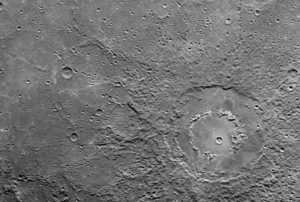

A fascinating aspect that captivates astronomers is the internal structure of Mercury. The Mariner-10 spacecraft’s instruments have unveiled an intriguing finding – Mercury possesses a relatively thin outer layer known as the crust. Surprisingly, beneath this crust lies a significantly more substantial metallic core, resembling a massive ball made up of metal. This core constitutes a staggering 80% of the planet’s mass and is encased by a mantle composed of basaltic rock. In stark contrast, Earth, Venus, and Mars boast smaller cores and thicker crusts.
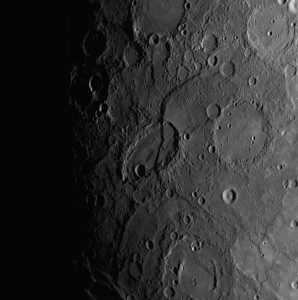
What is the reason for this? There are multiple explanations. One hypothesis suggests that several million years in the past, Mercury experienced two powerful collisions with celestial bodies similar in size to itself. The first collision caused the planet to nearly liquefy, causing its dense elements to sink and form a sizable core. The second impact resulted in the removal of a significant portion of Mercury’s outer crust.
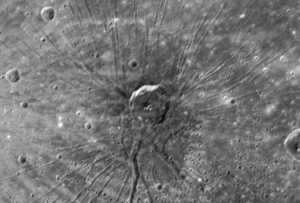

The Spider on Mercury.
Based on observations from Earth and spacecraft images, Mercury’s surface bears a striking resemblance to that of the Moon. However, the contrast between dark and light areas is less pronounced. Just like the Moon, Mercury experienced a period of volcanic activity in its history, resulting in the formation of lava flows on its surface. Additionally, the planet is characterized by a network of mountain ridges, depressions, fissures, with some reaching heights of 4 km and steep cliffs stretching hundreds of kilometers long and up to 3 km high.
On the surface of the planet, in certain regions, one can observe valleys that lack craters (which are usually shallower than those found on the Moon). Additionally, there is a solitary flat area known as the Heat Plain on the studied hemisphere of Mercury. It is believed to be composed of frozen lava that emerged from the planet’s interior subsequent to a colossal asteroid impact around 4 billion years ago. The average density of the soil is recorded to be 5.43 g/cm3.
Source of the photograph: MESSENGER, NASA/Johns Hopkins University Applied Physics Laboratory/Carnegie Institution of Washington.
Seasons
Mercury revolves around the Sun in a highly elongated elliptical path (with an eccentricity of e = 0.206), and its plane is inclined at an angle of 7° 00’15” to the ecliptic plane, making it one of the most inclined orbits in our Solar System. The axis of Mercury is nearly perpendicular to its orbit, resulting in a lack of significant seasonal variations on the planet. Therefore, there are minimal observable changes in seasons on Mercury.
There have been no natural satellites discovered for Mercury.
The initial exploration of Mercury was conducted by the American automatic interplanetary station Mariner-10, which was launched on November 3, 1973, using the M1a$/SepHaig rocket from Cape Canaveral Space Center. Its primary objective was to investigate Mercury and Venus.
The station made three flybys of the planet between 1974 and 1975. The closest approach of this space probe to Mercury was 320 kilometers.
“Mariner 10 was the sole spacecraft to fly past Mercury and conduct a close-range study of the planet. It mapped approximately half of Mercury’s surface.
On August 3, 2004, a new spacecraft named Mezzepdeg was launched towards Mercury, with plans to enter an elliptical orbit around the planet on March 18, 2011, and remain there for nearly a year.
To observe Mercury from Earth, one encounters a challenge. Due to its close proximity to the Sun, the planet is always seen in close proximity to the Sun. The angular distance between Mercury and the Sun reaches a maximum of 28.3°. As a result, Mercury can only be observed before sunrise or just after sunset, when it appears against the backdrop of the low-lying evening or morning sky. Furthermore, during these times, only half of Mercury’s disk is illuminated.
The apparent magnitude of Mercury varies from -1.9 to 5.5, making it visible to the naked eye under certain conditions.
In Roman mythology, Mercury (known as Hermes in Greek mythology) is revered as the god of trade, intellect, dexterity, deceit, thievery, and eloquence. He is associated with bestowing wealth and prosperity in trade, as well as being the god of gymnastics. Over time, Mercury also took on the role of a messenger of the gods and a guide for souls transitioning to the underworld of Hades.
By the conclusion of the 4th century BC, Mercury also assumed the role of the deity of sorcery and astrology. It was widely believed that he was the inventor of letters, numbers, units of measurement, and bestowed this knowledge upon humanity.
Mercury is the offspring of Zeus and the mountain nymph Maia. He was born within the confines of the grotto located on Mount Killeni in Arcadia. No one could surpass him in terms of agility, cunning, and thievery. Even while in diapers, Mercury conducted his inaugural act of theft – he absconded with 15 cows belonging to Apollo, strategically attaching branches to their feet in order to conceal his tracks. On one occasion, as a jest, he pilfered a scepter from Zeus, a trident from Poseidon, golden arrows and a bow from Apollo, and a sword from Ares.
Mercury sired a vast progeny, including Hermaphrodite (with Aphrodite as the mother), Pan (with Dryopa as the mother), Silenus (with Cybele as the mother), Autolycus (with Chiona as the mother), Daphnis (with one of the nymphs as the mother), and Abdera.
The god possessed several distinctive attributes, including a broad-brimmed hat, sandals with wings, and a caduceus, which was a winged staff traditionally carried by heralds and messengers. This staff had the power to reconcile enemies. Zeus granted Mercury these items in recognition of his invention of the lyre. The lyre, which was originally made from a turtle shell with bull veins stretched across it, served as the prototype for this musical instrument.
Mercury was worshipped by ancient pastoral tribes who resided in the valleys of the Nile, Tigris, and Euphrates rivers. The planet Mercury, which could be observed as a bright evening or morning star at different times of the year, was regarded as distinct celestial bodies by these ancient civilizations. As a result, Mercury was known by different names among various cultures. The Egyptians referred to the planet as Seth and Sor, while the Indians called it Buddha and Rogineya.
Until the 1960s, scientists held the belief that Mercury had a rotational period of 88 Earth days, the same as its orbital period around the Sun.
In 1965, the introduction of radar technology allowed for the precise measurement of Mercury’s revolution time. It was discovered that a day on Mercury lasts 58.7 Earth days.
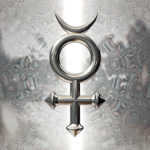
The symbol for Mercury in astronomy is a stylized depiction of the winged helmet worn by the god Mercury, along with his caduceus.
In 2009, scientists created the first comprehensive map of Mercury using images captured during the Mariner 10 and Messenger missions.
The concept of time on Earth is often taken for granted, with many people unaware that the measurement of time is relative. The duration of days and years, for instance, is based on physical factors such as the distance between a planet and the Sun. A year is defined as the time it takes for a planet to complete one orbit around the Sun, while a day is the time it takes for a planet to complete one full rotation on its axis. This same principle is employed when determining the length of a day on other celestial bodies within our solar system. It’s a common curiosity to wonder about the duration of a day on planets like Mars, Venus, and other celestial objects.
On our planet, the duration of a day is 24 hours, which corresponds to the time it takes for the Earth to complete one full rotation on its axis. However, the length of a day on other celestial bodies, such as Mars and other planets, varies significantly, with some having shorter days and others having much longer ones.
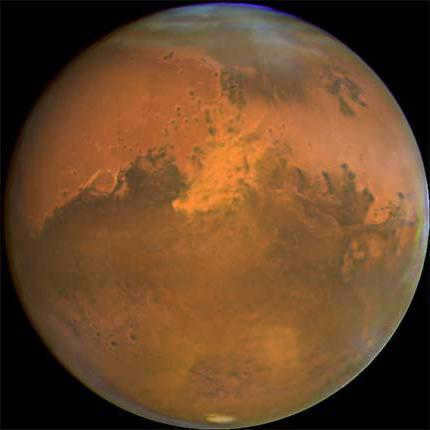

Calculating the duration
If you want to determine the length of a day on Mercury, you have two options: solar days or sidereal days. A sidereal day is the time it takes for the planet to complete one rotation on its axis. It is measured by observing the position of the stars in the sky. On Earth, a sidereal day lasts about 23 hours and 57 minutes.
A solar day, on the other hand, is based on the planet’s rotation relative to the Sun. It is similar to a sidereal day, but uses the Sun as the reference point. Keep in mind that a sidereal day and a solar day can have different durations.
What is the duration of a day on Mars in terms of the sidereal and solar system? On Mars, a sidereal day lasts for 24 and a half hours, while a solar day is slightly longer, lasting for 24 hours and 40 minutes. It is worth noting that a day on Mars is 2.7% longer than a day on Earth.
The duration of a day on Mars plays a crucial role in the planning of missions to explore the planet. In order to ensure proper synchronization with the Martian day, the vehicles sent to Mars are equipped with specially designed clocks that account for the 2.7% difference in time compared to Earth. This is particularly important as the rovers rely on solar power. Although an attempt was made to develop a clock that would factor in the solar day on Mars, it proved to be impractical and could not be implemented.
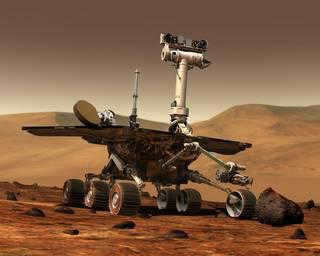
Martian time
If you know the length of a Martian day, you can calculate the duration of a Martian year. The seasonal pattern on Mars is similar to that of Earth: Mars has the same tilt as Earth (25.19°) in relation to its orbital plane. The distance between the Sun and the red planet varies during different periods, ranging from 206 to 249 million kilometers.
The temperature readings on Mars are different from those on Earth:
- The average temperature is -46°C;
- During the farthest distance from the Sun, the temperature drops to about -143°C;
- In summertime, the temperature is around -35°C.
Water on Mars
In 2008, scientists made a fascinating revelation. The Mars rover uncovered water ice at the planet’s poles. Prior to this revelation, it was widely believed that the surface only contained carbon dioxide ice. It was later discovered that precipitation in the form of snow occurs on the red planet, with carbon dioxide snow falling near the south pole.
Mars experiences storms throughout the year that span hundreds of thousands of kilometers, making it challenging to monitor surface activity.
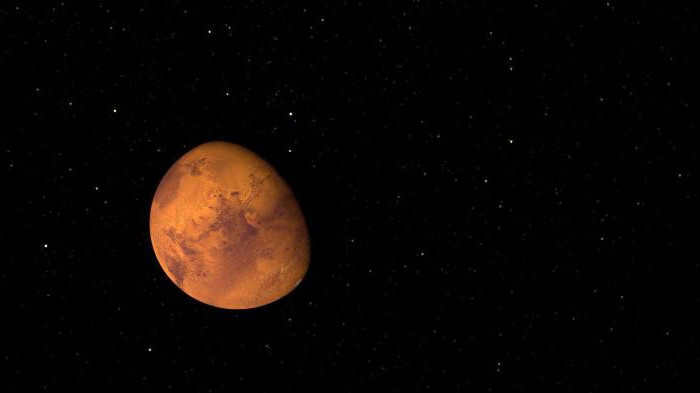

A year on Mercury
Around the Sun, the planet closest to it makes a circle for 88 Earth days, moving at a speed of 47.87 kilometers per second. A whole system of designation of Mercurian years has been developed.
When studying the question of how long a day lasts on Mercury in hours, mankind has made many sensational discoveries. They show that the planet closest to the Sun is different from Earth.
The Duration of a Year on Mercury
Mercury, a planet in close proximity to the Sun, completes one revolution around its axis in 58 Earth days. This means that a day on Mercury is equivalent to 58 Earth days. Furthermore, Mercury takes only 88 Earth days to orbit the Sun. This astounding revelation indicates that a year on Mercury is nearly three Earth months long, and while our planet completes a single orbit around the Sun, Mercury completes over four rotations. It is truly remarkable to consider that in just a day and a half on Mars, an entire year elapses on Mercury.
Duration on Venus
The duration on Venus is extraordinary. A single rotation on this celestial body takes 243 Earth days, while a complete orbit around the Sun takes 224 Earth days. It may appear peculiar, but such is the enigmatic nature of Venus.
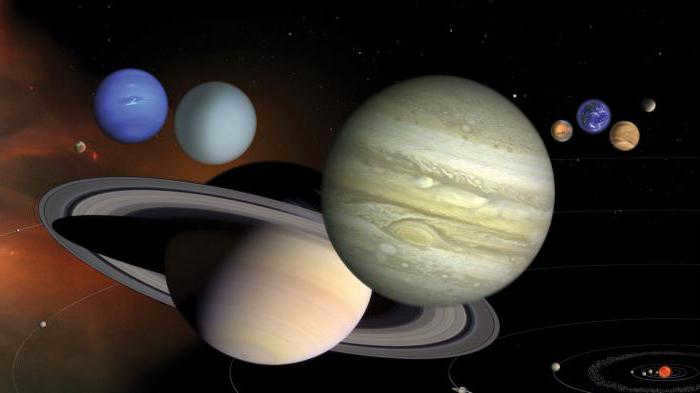
Duration of Time on Jupiter
Jupiter, being the largest celestial body in our solar system, is often assumed to have a significantly longer day compared to Earth. However, this is not the case as a day on Jupiter lasts only 9 hours and 55 minutes, which is less than half the duration of an Earth day. The rapid rotation of this gas giant around its axis contributes to its relatively short day. Additionally, this rapid rotation leads to the formation of constant hurricanes and intense storms on the planet.
Time on Saturn
A day on Saturn is approximately 10 hours and 33 minutes, which is the same as on Jupiter. In terms of a year, Saturn takes about 29345 Earth years to complete one orbit around the Sun.
Time on Uranus
Uranus is a unique planet, making it difficult to determine the length of a sidereal day. The sidereal day on Uranus lasts for 17 hours and 14 minutes. However, due to its extreme tilt, Uranus orbits the Sun almost on its side. This causes one pole to experience 42 years of continuous summer, while the other pole remains in darkness for the same period. As Uranus rotates, the illuminated pole switches, resulting in each pole being illuminated for 42 years. Scientists have determined that a day on Uranus lasts 84 Earth years, making it almost equal to one Uranian year.
